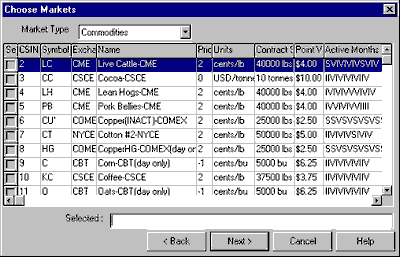
When selecting markets you should consider the following facts:
1) Analysis will only be done on the inclusive date range: the date range in common to all selected markets.
2) The selected markets must be economically related for the predictions to be valuable.
3) Only select as many markets as your computer's memory can hold. Generally each market will consume about 300k of computer memory. Ten markets will occupy 3 megabytes.
The control at the top allows you to choose from either stocks or commodities. Clicking on a column will cause the list to be sorted on that column. Each click after that will reverse the sort order. Clicking the check box at the left causes the stock or commodity to be selected; its symbol will appear in the selection list. A second click will uncheck it and remove it from the list. You can also type symbols directly in the list, separated by either spaces or commas and in either upper or lower case. If you run the same analysis every day, it is easiest just to have the selected symbols available in a text file and use the Windows Copy and Paste functions (Ctrl-C and Ctrl-V) to enter the list.
Normally a user will enter a Market Type of commodities, then select a few from the displayed list that are believed to be economically related. The commodity symbols will appear in the "Selected" window. Next, the user may change the market type to "Stock" and choose more markets that may be economically related to the commodities already chosen. The stock symbols will be added to the "Selected" window where stocks and commodities commingle with each other in an economic sense.
Which markets you choose will depend on your trading style, of course. For an example, we will focus on agricultural futures contracts. We've chosen ten very liquid contracts: C (Corn), O (Oats), S (Soybeans), W (Wheat), LC (Live Cattle), LH (Lean Hogs), CC (Cocoa), KC (Coffee), SB (World Sugar #11) and CT (Cotton), and we believe there is sufficient reason to combine these markets in a single exercise.
Press the "Next " button to continue by choosing a series.